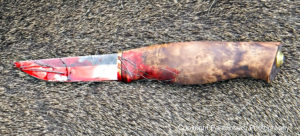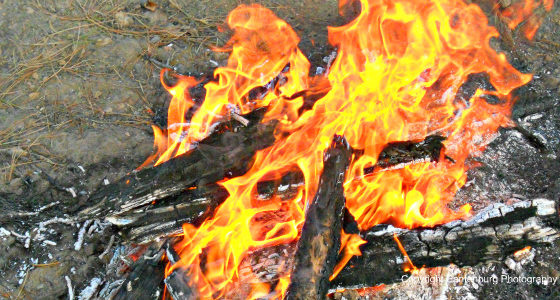Every survival/preparedness-type has opinions about the best survival/hunting/bushcraft/etc knife. But what about the knife you carry every day and use for everything?
by Leon Pantenburg
I belong to the “big knife, small knife” school of thought when it comes to packing cutlery. I want a four-to-six inch blade for a hunting knife, a seven-to-nine inch filleting knife for fish and a 12-to-18-inch machete or parang for chopping. (Actually, a better chopping tool is a hatchet or small axe!)
But I also take along a smaller, handier knife to do a lot of everyday tasks. This small knife will be carried most often and subsequently, get more use. So it needs to be chosen with care.

The Hawk is a user knife, able to handle a variety of tasks.
Don’t underestimate the smaller knives.
Several years ago, I was driving home from a Boy Scout campout, when a car ahead of me hit a deer. After checking on the occupants of the car (they were shaken, but unhurt) the driver and I followed the injured buck.
It had two broken legs, internal injuries and was in agonizing pain. We dialed 911, and found the state police would be at least half an hour getting there. So we put the deer down with the only tool available – my Kellem Hawk. The three-inch blade worked quickly and efficiently to end the animal’s suffering.
In another instance, I volunteered to help cook at the Azure Standard company picnic. We found there were 120 pounds of chicken quarters to be cut up. I had the only practical knife available, my L.T. Wright Next Gen.
The Next Gen opened up a pallet of boxes, and when the blade was cleaned, cut up 80 pounds of chicken. (We grilled 40 pounds of quarters for the big eaters.) Everyone who used the Next Gen loved it. The blade was still sharp at the end of all that work.
Here’s my preferencs in an EDC knife: I have certain standards. The blade should be between one to three inches long, with a user point. My (glove-size) large hands require a minimum four-inch handle and I prefer a bulky diameter. The material should be safe to use, even when wet. And durable.
For users, I prefer micarta because it seems to get tackier and “grippier” when wet. But I have a real weakness for beautiful wood, and own and use many knives with curly maple and desert ironwood handles.
We further break down the category into folder and rigid blade. (Check out my prejudices.)
Here are some of my current favorite rigid EDCs:
Old Hickory three-inch paring knife: My sister, Karla Pantenburg Moore, is a one of the most knowledgeable homesteader-types I know. Her go-to knife for many homestead tasks is a three-inch Ontario Old Hickory paring knife. The knives are cheap, reliable and do the job.
L.T. Wright Patriot: This is a great choice for people with small-to-medium hands. I don’t like a three-finger grip on a user knife, and that was the best I could do with the Patriot. But the cute little knife can be a real workhorse in the right hands, and any L.T. Wright knife is bulletproof. (Check out these video reviews)

Two favorites: The L.T. Wright Next Gen and WM1 are both workhorses.
L.T. Wright Next Gen: This is one of my favorite small knives. It has a three-inch blade, and a 4-1/2 inch handle. For me, it is just about perfect.
Fallkniven WM1: Fallkniven has a sterling reputation for quality cutlery, and the WM1 Sporting Knife upholds that tradition. A smallish fixed-blade knife, the WM1 is compact enough to take everywhere, but large enough handle many big knife tasks.
I carved a spoon with the WM-1 and found it to be a very good carver with its 2.75-inch, convex grind. It would also work for a neck knife.
Kellam Hawk: The Hawk™ features a beautiful dyed curly birch handle with a 3″ razor-sharp carbon steel blade. This knife has a full-tang construction with a brass bolster. These knives are hand made in Finland. The knife comes with a swinger-style dark brown leather sheath. As mentioned, this knife can handle just about anything.
Pocket knives
Great Eastern Slipjoint: I got this because I love classic, traditionally designed cutlery. The knife is big enough, with its four-inch handle, and 3-1/8-inch blades to be used comfortably for a lot of tasks. If need be, it could do a fine job of field dressing and skinning a deer.

The Great Eastern slipjoint has a generous handle and two well-designed blades.
Swiss Army Classic: My overall, most-carried knife ever is the tiny Classic. It rides on my keychain, and is used multiple times every day for everything imaginable.
I met a through hiker on the Pacific Crest Trail in Oregon a few years back, and a Classic was her choice for a backpacking knife. It was the only knife she had carried since leaving the Mexican border several months earlier.

The Swiss Army Knife Tinker is inexpensive, and can do the jobs of a much larger knife.
Swiss Army Tinker: I carry a Tinker on my belt everyday, even when I’m at work at my college office. The Tinker goes for under $20, and has just about everything I need in a pocket knife. Frequently, you can find a combo deal on Amazon.com pairing the Classic and the Tinker.
Most Swiss Army knives have toothpicks and tweezers in the handle, and these are some of the most useful tools imaginable.

The Opinel, top, and the Puma Birdhunter, bottom, both offer a lot. The folding fish knife in the center is also a useful design.
Puma Stockman Birdhunter: This three-bladed knife is one of the best small game knives ever. The different styles of blades are ideal for gutting and skinning upland game or birds, and the handle is comfortable for wood carving.
Opinel: This French import is inexpensive and has a unique, revolving ring for securely locking the blade in place. Opinels come in all sizes. The smallest Opinel, No. 2, has a 3.5-cm blade and the largest knife, No. 12, a 12-cm blade.
I find the carbon steel blades hold an edge very well, and if the blade it wiped off after use there shouldn’t be any problems with rust.
Honorable mention:
These knives are in their own categories, and bear mention because this is my website and I like them.
Bark River Gunny: The 3-3/4-inch blade disqualifies this knife from consideration, but the Gunny remains one of my most-used knives.

This Bark River Gunny with a curly maple handle.
Mora 840 Companion: The blade is just under four inches, so that puts it in the mid-size group. But the cost and quality make it a knife that everyone can afford to use.
Leatherman WAVE: This multi-tool has all sorts of really cool gadgets, including a quality blade. The blade is about three inches long, and it can serve as a small game knife.
I’ve heard of people field dressing deer with the WAVE, but that is nothing I intend to try. The collection of tools make this one of the handiest EDCs available.
So that’s my EDC knife list as of right now. My choices are probably different from yours, and my list tends to change and evolve as I check out new products.
Probably the only thing to remember about any EDC knife is that it’s useless if it is left at home, or in the vehicle at the trailhead. The only valuable EDC/survival/bushcraft/etc knife is the one you have with you!
Please click here to check out and subscribe to the SurvivalCommonSense.com YouTube channel – thanks!





Leave a Reply